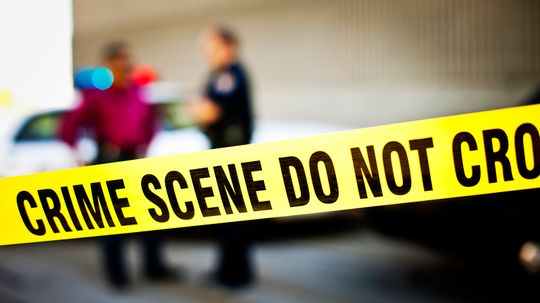Physical Science
Physical science is the study of the physical world around you. Learn about everything from electricity to magnetism in this section.

Brown Noise vs. White Noise: Which Is Best for Quality Sleep?

Can a sound wave kill you?

Can two cans and a string really be used to talk over a distance?

7 Types of Alcohol for Drinking, Cleaning and More

Understanding the Empirical Formula in Chemistry

The Most Expensive Metal in the World Isn't Gold or Platinum

How Electricity Works

How Faraday Cages Work

How Gasoline Works

What Does Mummification Have to Do With Gene Hackman?

What do bugs have to do with forensic science?

5 Things You Didn't Know About Autopsies

How Alchemy Paved the Way for Chemistry

How did Nikola Tesla change the way we use energy?

Time May Not Exist, Say Some Physicists and Philosophers

Why Does Ice Stick to Your Fingers?

What if I forgot to remove a piercing before an MRI?

A Kid-friendly Introduction to Magnets and Magnetism

What's the Hardest Math Problem in the World? Try These 9

8 Types of Data That Inform Insights and Relationships

Congruent Angles: Definition, Symbol and Key Theorems

Tonnes vs. Tons: Metric vs. Imperial Measurements Strike Again

The Most Expensive Liquid Is 26,000x the Price of Human Blood

5 Hugely Fun Facts About Mass (Not Weight)

The Demon Core: A Tale of Atomic Ambition and Tragic Fate

Half-Life Formula: Components and Applications

Could an 'X17 Particle' Hint at a Fifth Force in the Universe?

Why Are School Buses Yellow?

HowStuffWorks: How To Draw An Impossible Shape

What Are the Colors in the Visible Spectrum?
Learn More / Page 7
Fusion reactors will use abundant sources of fuel, will not leak radiation above normal background levels, and will produce less radioactive waste than current fission reactors. Learn about this promising power source.
By Patrick J. Kiger & Craig C. Freudenrich
Learn what really goes on when a CSI "processes a crime scene" and get a real-world view of crime scene investigation from a primary scene responder with the Colorado Bureau of Investigation.
By Julia Layton
NASA's Mars rovers are sending 3-D images to Earth, so we can see depth and texture on the Martian surface. And how do we see this depth and texture? 3-D glasses, of course! Check out how they work.
Advertisement
I was watching an old movie today, and two kids (neighbors) were talking to each other using two tin cans and a string. Does that really work? If so, why does it work?
Some of the brightest minds in history have focused their intellects on the subject of light. Einstein even tried to imagine riding on a beam of light. We won't get that crazy, but we will shine a light on everything scientists have found so far.
What makes sound a weapon? Review the basics of sound and discover exactly how the LRAD produces its "beam of sound." We'll also explore LRAD's hailing and warning abilities and other uses for sound.
If water is made up of hydrogen and oxygen, why can't we breathe underwater? It has to do with how molecules combine and how the human lung functions.
Advertisement
Ever wondered exactly what they "artificial flavors" in your candy are, and why no specific ingredients are listed? Find out in this article.
Electricity completely surrounds us whether you're charging your cell phone or watching the sky light up during a violent thunderstorm. For most of us, modern life would be impossible without it, and the natural world relies on it.
The thought of an autopsy usually provokes fear, apprehension or extreme anxiety in people. Cut through the mystery of this process and learn the details of the preparation, procedures and tools used to perform an autopsy.
Viagra is one of the best-known drugs of all time. Nearly every adult in America has heard of the drug and can tell you what it does. Find out how this high-profile medication works its magic.
Advertisement
When you watch crime drama on TV, you don't usually see what happens after the police and ambulance leave a murder scene. One thing those people do not do is clean up the blood. That's the work of a whole different team.
By Julia Layton
Atom smashers tell us about the fundamental structure of matter, the forces holding it together and the origins of the universe. Discover how scientists use particle accelerators to break atoms apart to learn about the nature of reality.
Pianos lose their tuning, guitars fall out of key -- even church organs need to be tuned every now and then. For centuries, the only sure-fire way to tell if an instrument was in tune was to use a tuning fork.
Wavelengths are used to measure the size of a wave. Learn about wavelengths in this article.
Advertisement
Voltage is how we measure the difference in electric potential energy. Learn about what voltage is from this article.
Thanks to our voracious appetite for energy, the element long linked with nuclear weapons is taking on a new role. Where does the hunt begin for uranium?
Did you ever wonder how to measure how fast sound travels in the air? Read this article to learn how to measure sound travel in the air.
Thanks to the Faraday cage, we can control electricity and make it safer for our computers, cars and other inventions.
Advertisement
You want to learn how to read the electric power meter in your home to see if the meter reader sent by the electric company was accurate. This article will teach you how to read a power meter.
First there was Volvo. Then came IKEA. Well get ready for the next major Swedish export: snus, a smokeless tobacco product, similar to dip or chew.
We've been observing and experimenting in the name of science for centuries. But who deserves the honor of being humanity's very first scientist? Is it Euclid, Darwin, Galileo or someone else?
Explosions, fires and dangerous radiation levels dominated the headlines after the March 11 earthquake and tsunami sparked a nuclear crisis in Japan. How did so many safety measures fail?
Advertisement
A unit circle is an important part of trigonometry and can define right angle relationships known as sine, cosine and tangent.
A multiplication table is an easy-to-use grid of numbers that can help you learn to multiply quickly by using the chart and, eventually, your memory.
























